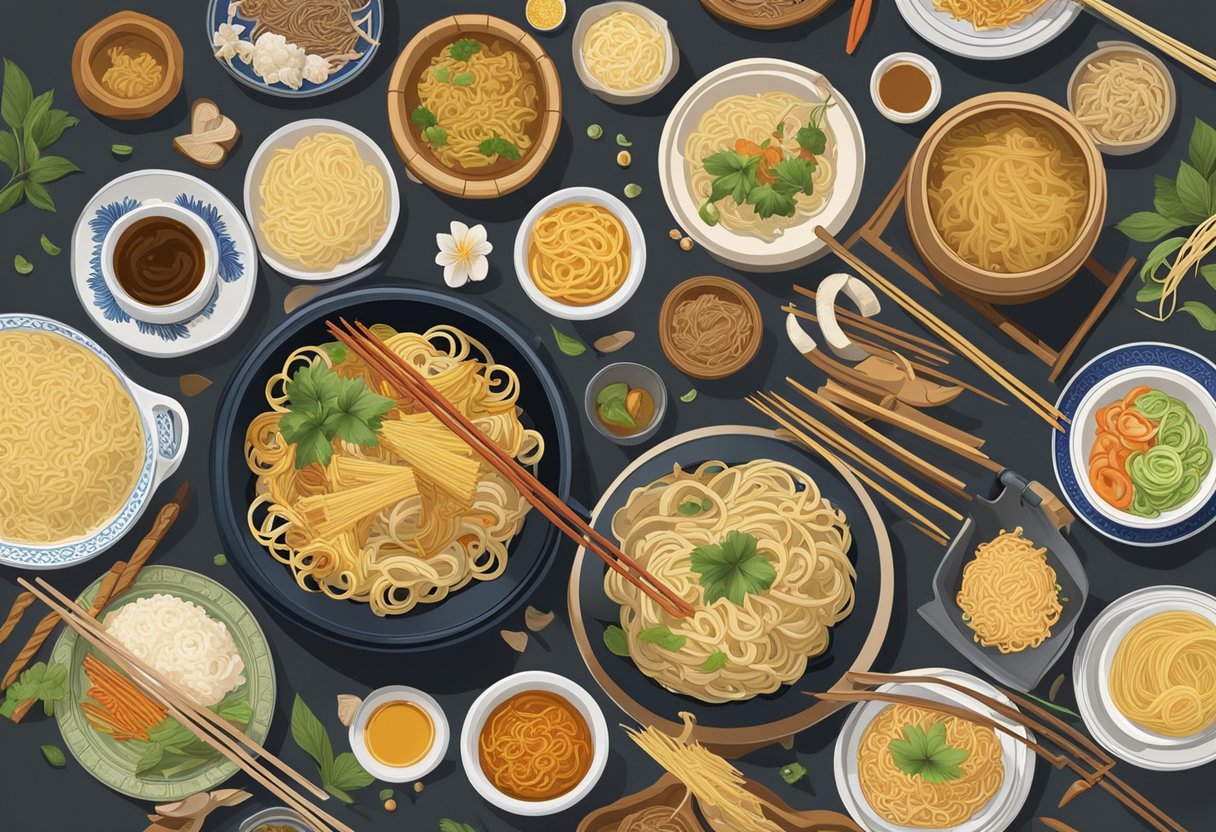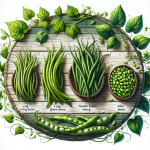Types Of Asian Noodles
Asian cuisine is known for its wide range of noodles, which are an essential part of many dishes. Noodles have been a staple food in Asia for centuries and have a rich history and cultural significance. They come in various shapes, sizes, and textures, and each type has its unique flavor and cooking method.
The types of Asian noodles are broadly divided into three categories: wheat noodles, rice noodles, and glass noodles. Wheat noodles are made from wheat flour and are commonly used in Japanese, Chinese, and Korean cuisine. Rice noodles are made from rice flour and are used in Thai, Vietnamese, and Chinese dishes. Glass noodles, also known as cellophane noodles, are made from mung bean starch and are commonly used in Korean and Chinese cuisine.
Understanding the different types of Asian noodles can help you choose the right type for your dish and ensure that it is cooked correctly. In this article, we will explore the different types of Asian noodles, their historical and cultural significance, noodle preparation and cooking techniques, common Asian noodle dishes, and selecting and storing Asian noodles.
Key Takeaways
- Asian cuisine has a wide range of noodles that come in various shapes, sizes, and textures.
- The types of Asian noodles are broadly divided into three categories: wheat noodles, rice noodles, and glass noodles.
- Understanding the different types of Asian noodles can help you choose the right type for your dish and ensure that it is cooked correctly.
Historical and Cultural Significance

Asian noodles have a rich history and cultural significance that spans back thousands of years. From China to Japan, Korea, and Vietnam, noodles have become an integral part of Asian cuisine and culture.
History of Asian Noodles
The origin of Asian noodles can be traced back to China, where they were first made during the Han dynasty (206 BCE – 220 CE). Noodles were initially made from wheat flour and were considered a luxury food item. Over time, noodles became more widely available and were enjoyed by people of all social classes.
In Japan, noodles were introduced during the 9th century by Buddhist monks. They were initially made from wheat flour, but over time, different types of noodles were developed using ingredients such as buckwheat and sweet potato.
Korean noodles, known as “guksu,” have a long history and were first mentioned in Korean literature during the Goryeo dynasty (918-1392 CE). Korean noodles are made from wheat flour, potato starch, or sweet potato starch and are often served in soups or stir-fried dishes.
In Vietnam, noodles are a staple food and are used in a variety of dishes, including pho and bun cha. Vietnamese noodles are made from rice flour and are often served with fresh herbs and vegetables.
Noodles in Asian Celebrations
Noodles play an important role in many Asian celebrations and are often served during special occasions such as weddings, birthdays, and New Year’s celebrations. In China, long noodles are believed to represent longevity and are often served during birthday celebrations. In Japan, soba noodles are traditionally eaten on New Year’s Eve to symbolize good fortune and to bring in the new year.
Overall, Asian noodles have a rich history and cultural significance that has been passed down from generation to generation. Today, they continue to be an integral part of Asian cuisine and are enjoyed by people all over the world.
Types of Asian Noodles
Asian cuisine is widely known for its diverse range of noodles, which vary in shape, texture, and flavor. Noodles are a staple in many Asian countries and are used in soups, stir-fries, salads, and other dishes. In this section, we will be discussing the three main types of Asian noodles: wheat-based, rice-based, and starch-based noodles.
Wheat-Based Noodles
Wheat-based noodles are made from wheat flour and water. They are commonly used in Japanese cuisine and are known for their chewy texture. Some popular wheat-based noodles include:
-
Ramen: Originally from Japan, ramen noodles are made from wheat flour, water, salt, and an alkaline solution called kansui. Ramen noodles are thin, curly, and have a slightly chewy texture. They are often served in a savory broth with various toppings such as sliced pork, green onions, and eggs.
-
Udon: Another Japanese noodle, udon noodles are thick and chewy. They are made from wheat flour, water, and salt and are often served in a hot broth with toppings such as tempura, tofu, and green onions.
-
Soba Noodles: Soba noodles are thin, brown noodles made from a mixture of wheat flour and buckwheat flour. They have a nutty flavor and are often served cold with a dipping sauce or in a hot broth.
Rice-Based Noodles
Rice-based noodles are made from rice flour and water. They are commonly used in Southeast Asian cuisine and are known for their delicate texture. Some popular rice-based noodles include:
-
Rice Noodles: Rice noodles are thin, translucent noodles that are commonly used in Vietnamese and Thai cuisine. They are often used in soups and stir-fries and can be found in various widths.
-
Glass Noodles: Also known as cellophane noodles or bean thread noodles, glass noodles are made from mung bean starch or potato starch. They are translucent and have a slightly chewy texture. They are commonly used in Chinese and Korean cuisine and are often used in soups and stir-fries.
Starch-Based Noodles
Starch-based noodles are made from various types of starch such as sweet potato starch, potato starch, and mung bean starch. They are commonly used in Korean and Chinese cuisine and are known for their chewy texture. Some popular starch-based noodles include:
-
Japchae: Japchae is a Korean dish made with sweet potato starch noodles. The noodles are stir-fried with vegetables and meat and are often served as a side dish.
-
Dangmyeon: Dangmyeon is a type of Korean glass noodle made from sweet potato starch. It is often used in stir-fries and soups.
In conclusion, Asian noodles come in a variety of shapes, textures, and flavors. Whether you prefer chewy wheat-based noodles or delicate rice-based noodles, there is a noodle out there for everyone.
Noodle Preparation and Cooking Techniques
Cooking Fresh Noodles
Fresh noodles are a popular choice in Asian cuisine, and they offer a unique texture and flavor that cannot be achieved with dried noodles. To cook fresh noodles, bring a pot of water to a rolling boil and add the noodles. Cook for 1-3 minutes, depending on the thickness of the noodles, and then drain them. Rinse the noodles with cold water to stop the cooking process and prevent them from sticking together.
Rehydrating Dried Noodles
Dried noodles are a convenient option for those who don’t have access to fresh noodles. To rehydrate dried noodles, soak them in hot water for 5-10 minutes until they are soft and pliable. Drain the water and rinse the noodles with cold water to remove any excess starch. Dried noodles can be used in a variety of dishes, such as stir-fries, soups, and salads.
Creating Broths and Soups
Broths and soups are an essential part of many Asian noodle dishes, and they can be made in a variety of ways. To make a simple broth, combine chicken or vegetable stock with aromatics such as ginger, garlic, and scallions. Season the broth with soy sauce, fish sauce, or miso paste for added flavor. To make a soup, add cooked noodles to the broth along with vegetables, proteins, and herbs. Simmer the soup until the ingredients are cooked through and the flavors have melded together.
When cooking noodles, it’s important to follow the package instructions and use the appropriate cooking method. Boiling is the most common method for cooking noodles, but frying and steaming can also be used depending on the dish. Fresh noodles can be boiled, fried, or steamed, while dried noodles are best boiled or rehydrated. By following these simple techniques, anyone can create delicious and authentic Asian noodle dishes.
Common Asian Noodle Dishes
Asian cuisine is known for its diverse and delicious noodle dishes. From stir-fried noodles to noodle soups and cold noodle salads, there is a wide range of noodle dishes to choose from. Here are some popular Asian noodle dishes that are enjoyed worldwide.
Stir-Fried Noodle Varieties
Stir-fried noodles are a staple in Asian cuisine and are enjoyed in many different varieties. Lo mein and chow mein are two popular Chinese stir-fried noodle dishes that are made with wheat noodles. Lo mein is typically made with soft noodles, while chow mein is made with crispy noodles. Japchae is a Korean dish that features sweet potato starch noodles stir-fried with vegetables and meat. These dishes are typically seasoned with soy sauce, oyster sauce, or other flavorful sauces.
Noodle Soups and Broths
Noodle soups and broths are another popular way to enjoy Asian noodles. Pho is a Vietnamese noodle soup that features rice noodles, beef broth, and various herbs and spices. Ramen is a Japanese noodle soup that typically features wheat noodles in a pork or chicken broth. Both of these dishes are typically served with meat, vegetables, and other toppings.
Cold Noodle Salads
Cold noodle salads are a refreshing way to enjoy Asian noodles, especially during the summer months. Pad Thai is a popular Thai dish that features rice noodles, vegetables, and peanuts in a sweet and savory sauce. Naengmyeon is a Korean dish that features cold buckwheat noodles in a tangy broth. Both of these dishes are typically served with fresh herbs and vegetables.
Overall, Asian cuisine offers a wide range of delicious noodle dishes that are enjoyed worldwide. Whether you prefer stir-fried noodles, noodle soups, or cold noodle salads, there is a noodle dish out there for everyone to enjoy.
Selecting and Storing Asian Noodles
Shopping for Noodles
When it comes to shopping for Asian noodles, there are several options available. Asian grocery stores are a great place to start, as they typically offer a wide variety of noodles that may not be available at regular grocery stores. Online shopping is another convenient option, as it allows you to browse and purchase noodles from the comfort of your own home.
A guide to Asian noodles can be helpful when shopping, as it can provide information on the different types of noodles and their uses. It is important to note that some noodles are better suited for certain dishes than others, so it is helpful to have an idea of what dish you will be making before selecting a noodle.
Storage Tips
Asian noodles come in both dry and fresh varieties. Dry noodles have a longer shelf life and can be stored in a cool, dry place for several months. Fresh noodles, on the other hand, should be used within a few days of purchase and can be stored in the refrigerator.
It is important to check the expiration date on the package before purchasing or consuming any noodle. Once opened, noodles should be stored in an airtight container to prevent moisture from getting in and causing the noodles to become sticky or clump together.
Overall, selecting and storing Asian noodles is a fairly straightforward process. By following these tips and using a guide to Asian noodles, you can ensure that you are selecting the right noodle for your dish and storing it properly for optimal freshness.






